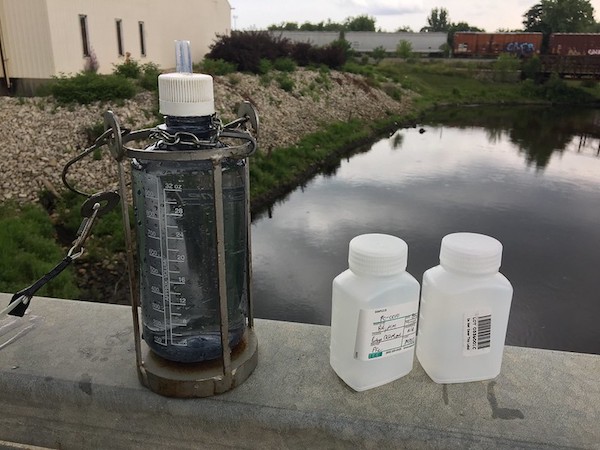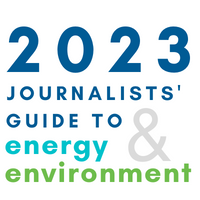SEJournal Online is the digital news magazine of the Society of Environmental Journalists. Learn more about SEJournal Online, including submission, subscription and advertising information.
 |
| Sample bottles used for PFAS testing in Michigan's Kalamazoo River watershed in 2018. Photo: Michigan Department of Environment, Great Lakes, and Energy via Flickr Creative Commons (CC BY-ND 2.0). |
Issue Backgrounder: EPA To Propose Plan Soon for First PFAS Drinking Water Rule
By Joseph A. Davis
Sometime later this year, the U.S. Environmental Protection Agency will try to regulate the toxic chemicals known as PFAS in the country’s drinking water. There will be a fuss.
 |
Environmental journalists (we hope) will be called on to explain the problem, and the cable networks will call on serious environmental reporters (we also hope) to cover it. But (we fear) they may have to do so in too-short segments.
And it’s not a simple story. So it may be time for some useful guidance.
First off, PFAS is a convenient name for per- and polyfluoroalkyl substances, a family of chemical substances. We used to say there were more than 4,000 of them, but today experts are reporting that they have identified more than 9,000.
The chemicals have been widely used in industry and commerce for decades, and have been handled carelessly during much of that time because their dangers to human health were not well understood.
Now it’s becoming clearer that some PFAS substances harm human health. With enough exposure, current research suggests PFAS may cause decreased fertility or high blood pressure during pregnancy; low birth weight or developmental delays in children; increased risk of prostate, kidney and testicular cancers; lowered immune response; hormonal disruption; and elevated cholesterol and obesity.
PFAS are widespread and persistent in the
environment. And they are “bioaccumulative”
— stored in the body where they build up.
Worse yet, PFAS are widespread and persistent in the environment. That is, they don’t break down easily. And they are “bioaccumulative” — stored in the body where they build up, especially when we ingest liquids, plants or animals contaminated with them.
Most people already have some level of PFAS in their blood. And most cities already have some level of PFAS in their drinking water. Because they are persistent and bioaccumulative, and because human exposure comes from many sources (e.g., some microwave popcorn), lifetime exposure matters.
Public worries, thorny politics
PFAS burst into the news way back in 2015-2016, when a Teflon chemical known as PFOA was found in drinking water in communities on the border of New York and Vermont. In the next few years, public concern erupted and spread across the United States.
As the Trump administration set up its deregulatory regime, the Pruitt EPA was forced to deal with it (more or less, mostly less). Or — you might think — the Pruitt EPA worked to keep it out of the headlines.
In May 2018, then-EPA Administrator Scott Pruitt hosted a “National Leadership Summit” on PFAS, which included a lot of state officials. It was not exactly a public meeting. Some reporters were invited, but many who were covering PFAS were not.
There was media consternation. Ellen Knickmeyer, an Associated Press reporter trying to cover the meeting, was physically ejected from the EPA building by a security guard. On camera. This elevated Knickmeyer to the pantheon of environmental journalism.
That was a symptom of (among other things) how thorny an issue PFAS really is. But the Biden EPA, under Administrator Michael Regan, has made positive efforts to do better, and has put forth a PFAS Strategic Roadmap.
The big problem is not just that PFAS are nasty, but that there are so many of them, and that so many jurisdictions, state, federal and local, are worrying about them. Many are already acting on their own by setting state PFAS drinking water standards. Every state is different.
And the PFAS problem crosscuts most of the environmental laws the EPA must administer — not just the Safe Drinking Water Act but the Clean Water Act, the Toxic Substances Control Act, the Resource Conservation and Recovery Act, the Emergency Planning and Community Right-to-Know Act and others.
And remember that a lot of other federal agencies (like the military) are involved as well.
PFAS drinking water standard on the way
The Biden-Regan EPA has committed itself to proposing a hard drinking water standard for PFAS by the end of 2022, which means it should pop very soon. This would be a proposed rule, and the EPA plans to make it final by the end of 2023.
Technically (and the Safe Drinking Water Act, or SDWA, gets technical very fast) it’s called a national primary drinking water regulation. That means it would be legally enforceable, would specify treatment methods, require monitoring and require reporting of contamination to the public.
Moving a major regulation from proposed to final in a single year is pretty ambitious. The complexity of any PFAS rule (think 9,000 chemicals) would be enormous. But the EPA has already embarked on the effort through a number of steps.
Part of an effective strategy will be picking
a manageable number of PFAS chemicals
and selecting the ones that matter the most.
Part of an effective strategy will be picking a manageable number of PFAS chemicals and selecting the ones that matter the most. Yup, the EPA’s been working on that. Under SDWA procedures, the EPA follows a five-year plan for adding contaminants to the regulated list. And it has already beefed up the PFAS items on that list.
One way to deal with the huge number of PFAS chemicals is not to test for each individually, but to screen for a larger group or to find ways to test for groups of PFAS compounds. There are promising methods.
One approach takes advantage of the reason PFAS are so durable, because of the strong chemical bond between the fluorine atom and the carbon atom. All PFAS have this pair. The EPA has already published “Draft Method 1621 for Adsorbable Organic Fluorine.” This method uses gas chromatography to find organofluorines but does not identify all PFAS variants. It’s a screening tool.
Water treatment vs. prevention
If your drinking water utility finds significant amounts of PFAS in its product, that is not good news. Right now, there are only three treatment methods proven effective at removing PFAS from drinking water. One is granular activated carbon filters. Another is ion exchange resins, and the third is high-pressure membrane systems.
Sadly, all these methods are high tech and expensive to implement, especially at scale. None are widely used for public water systems.
One upshot is that it is easier and more effective to prevent the PFAS from getting into the water in the first place. That means tighter controls on the disposal of PFAS and their release into the environment.
There are a whole lot of ways of doing that — under a range of environmental laws. But the SDWA itself contains one: source water assessment and protection. While the EPA is involved in these, they don’t so much involve iron-fisted regulation as state and local involvement and cooperation. Plus: after the damage is done, they are less useful.
Nobody will say this, but most of the bigger drinking water utilities are political — or, to put it more delicately, they operate within political and financial constraints. Most drinking water professionals are dedicated, responsible people who make public health a No. 1 goal. But face it: A lot of them operate under the thumb of boards and committees who are (or are ultimately responsible to) elected officials.
One reason they are slow to implement major corrections is that the changes will probably raise the rates of the ratepayers who elect the board. Or un-elect them. And this is why some utility officials say they want to avoid panicking the public.
Public debate opens door to misinformation
Once the EPA proposes a PFAS drinking water regulation, it will go out for public comment — “public” in this case including the many interests who have a stake, from environmentalists to equipment makers.
There is likely to be a passionate, political debate and environmental journalists will be called on to cover it.
There will be plenty of dire warnings
and plenty of simplistic moral outrage.
There will be fear and alarm. There will be
misinformation and disinformation.
There will be plenty of dire warnings and plenty of simplistic moral outrage. There will be fear and alarm. There will be misinformation and disinformation. There will be opportunists and profiteers. And we will cover that.
But it will be helpful to remember — and remind people — of the scale and complexity of the problem.
For environmental journalists, sharply challenging the EPA is an indoor sport. But it is important to keep sight of the fact that the EPA has already been doing a lot about PFAS in drinking water — heroically, intelligently and aggressively.
Look, for example, at this list of EPA actions to address PFAS, or this list of consultations and stakeholder engagements, among some of what the EPA has already pursued on PFAS, along with other agencies.
Already, the Biden EPA has put out “health advisories” on PFAS in drinking water. Those are nonbinding best-guess estimates of just how much of which chemicals people need to worry about.
Under big spending legislation like the Bipartisan Infrastructure Bill, the EPA is already granting state and local agencies serious funds to grapple with the problem. The EPA faces the sticky political problem of meshing with the states who have already set their own PFAS drinking water standards.
And you can be sure the Regan EPA is already confronting the environmental justice aspect of this — while it continues to grapple with the bigger environmental justice problem of communities that lack safe or treated drinking water at all.
[Editor’s Note: For more, check out our primer to prep for reporting on PFAS, Toolboxes on using a toxics database to ID a loophole in PFAS releases and another database to track PFAS drinking water contamination, along with TipSheets on EPA’s PFAS plans and drinking water contamination. Plus, get PFAS-related headlines from EJToday.]
Joseph A. Davis is a freelance writer/editor in Washington, D.C. who has been writing about the environment since 1976. He writes SEJournal Online's TipSheet, Reporter's Toolbox and Issue Backgrounder, and curates SEJ's weekday news headlines service EJToday and @EJTodayNews. Davis also directs SEJ's Freedom of Information Project and writes the WatchDog opinion column.
* From the weekly news magazine SEJournal Online, Vol. 7, No. 40. Content from each new issue of SEJournal Online is available to the public via the SEJournal Online main page. Subscribe to the e-newsletter here. And see past issues of the SEJournal archived here.













 Advertisement
Advertisement 



